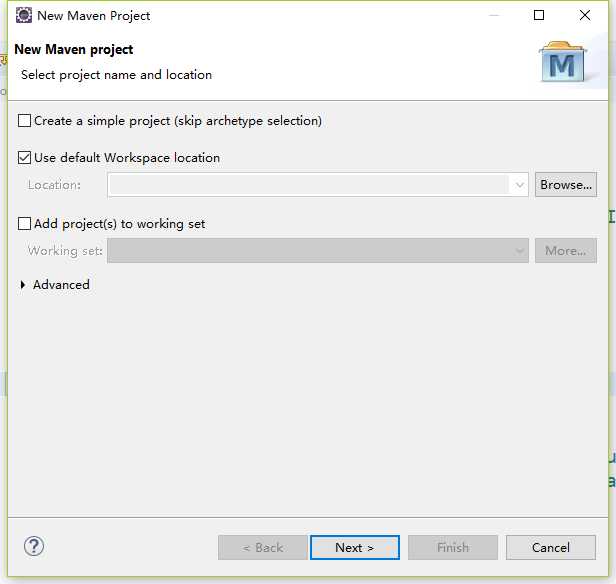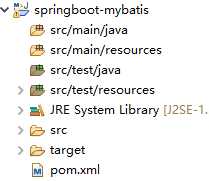标签:junit clip oid out cti 情况下 1.0 好的 util
时隔两个月的再来写博客的感觉怎么样呢,只能用“棒”来形容了。闲话少说,直接入正题,之前的博客中有说过,将spring与mybatis整个后开发会更爽,基于现在springboot已经成为整个业界开发主流框架的情况下,今天在这里就直接将mybatis整合spring boot了。
先简单地提一下Spring boot。在Mybatis还没火起来之前,大家用的是SSH(Struts2+Spring+Hibernate),之后mybatis以其小巧轻便的优点成为中小型项目的首选,与此同时基于Spring的自家mvc框架SpringMVC也火起来了,于是开发的框架又成了SSM(SpringMVC+Spring+Mybatis),但是Spring和Spring MVC本是同源,叫起来还得分开叫真是头疼,然后Spring boot出现了,它是基于Spring4的条件注册的一套快速开发整合包,同时又整合了Spring MVC了,所以说SpringMVC的那一套注解可以原封不动地搬来用。同时Spring boot为了解决Spring框架需要进行大量的配置的问题又引入自动配置的概念,也就是说能用注解我绝不用配置文件。关于Spring boot具体一点的东西我就直接在下面结合代码里讲了。
首先呢,新建一个maven项目,记得勾选上create a simple project

之后的Group id、Artifact Id之类的就可以随便填了,以下是我建好的项目结构

项目建好后第一件事,添加依赖
<parent> <groupId>org.springframework.boot</groupId> <artifactId>spring-boot-starter-parent</artifactId> <version>2.0.3.RELEASE</version> <relativePath/> <!-- lookup parent from repository --> </parent> <properties> <project.build.sourceEncoding>UTF-8</project.build.sourceEncoding> <project.reporting.outputEncoding>UTF-8</project.reporting.outputEncoding> <java.version>1.8</java.version> </properties> <dependencies> <dependency> <groupId>org.springframework.boot</groupId> <artifactId>spring-boot-starter</artifactId> </dependency> <dependency> <groupId>org.springframework.boot</groupId> <artifactId>spring-boot-starter-test</artifactId> <scope>test</scope> </dependency> <dependency> <groupId>org.springframework.boot</groupId> <artifactId>spring-boot-starter-web</artifactId> </dependency> <dependency> <groupId>org.mybatis.spring.boot</groupId> <artifactId>mybatis-spring-boot-starter</artifactId> <version>1.3.2</version> </dependency> <dependency> <groupId>mysql</groupId> <artifactId>mysql-connector-java</artifactId> </dependency> <dependency> <groupId>junit</groupId> <artifactId>junit</artifactId> </dependency> </dependencies> <build> <plugins> <plugin> <groupId>org.springframework.boot</groupId> <artifactId>spring-boot-maven-plugin</artifactId> </plugin> </plugins> </build>
解释一下几个关键的包
spring-boot-starter-parent:项目可以通过继承spring-boot-starter-parent包来获得一些合理的默认配置,在在dependencies里的部分配置可以不用填写version信息,自动继承parent包的版本,
当然也可以不用。
spring-boot-starter:这是Spring Boot的核心启动器,包含了自动配置、日志和YAML。
spring-boot-starter-web:构建Web,包含RESTful风格框架SpringMVC和默认的嵌入式容器Tomcat,就是这个包整合了Spring mvc,同时自带嵌入式tomcat意味着我们启动项目时就只要运行main方法就行
不用再跑eclipse上自带的tomcat了
mybatis-spring-boot-starter:这个就没什么好说的,官方提供的spring boot和mybatis的整合包。
包导完之后我的习惯是先把整个项目的包结构搭建起来

然后在最外层的包里面写启动类,老规矩先贴代码
package com.fiberhome; import org.springframework.boot.SpringApplication; import org.springframework.boot.autoconfigure.SpringBootApplication; @SpringBootApplication public class Application { public static void main(String[] args) { SpringApplication.run(Application.class, args); } }
这里只有一个注解@SpringBootApplication,但是作用却大得惊人,control键然后点击该注解看源码可知它替代了@@SpringBootConfiguration、@EnableAutoConfiguration、@ComponentScan这三个注解的功能。接下来解释这个三个注解的作用,理解了这三个注解,自然理解了@SpringBootApplication。
Springboot可以根据你添加的jar包来配置你项目的默认配置,比如当你添加了mvc的jar包,它就会自动配置web项目所需的配置<context:component-scan>,紧接着把我的实体类(User.java)代码贴出来
package com.fiberhome.pojo; import org.springframework.stereotype.Component; @Component public class User { private Long id; private String username; private int age; public Long getId() { return id; } public void setId(Long id) { this.id = id; } public String getUsername() { return username; } public void setUsername(String username) { this.username = username; } public int getAge() { return age; } public void setAge(int age) { this.age = age; } }
然后我们从底层的代码写起,先是mapper接口
package com.fiberhome.mapper; import java.util.List; import org.apache.ibatis.annotations.Mapper; import com.fiberhome.pojo.User; @Mapper public interface UserMapper { //获取用户名单 public List<User> getUser() throws Exception; //根据id删除用户 public void deleteUser(int id)throws Exception; //新增用户 public void addUser(User user)throws Exception; }
然后是对应该mapper接口的user.xml文件
<?xml version="1.0" encoding="UTF-8"?> <!DOCTYPE mapper PUBLIC "-//mybatis.org//DTD Mapper 3.0//EN" "http://www.mybatis.org/dtd/mybatis-3-mapper.dtd"> <mapper namespace="com.fiberhome.mapper.UserMapper"> <select id="getUser" resultType="com.fiberhome.pojo.User"> select * from user </select> <delete id="deleteUser" parameterType="Integer"> delete from user where id =#{id} </delete> <insert id="addUser" parameterType="com.fiberhome.pojo.User"> insert into user(id,username,age)values(#{id},#{username},#{age}) </insert> </mapper>
紧接着是Service层的代码
UserService.java
package com.fiberhome.service; import java.util.List; import com.fiberhome.pojo.User; public interface UserService { //显示所有用户 public List<User>getUser()throws Exception; //根据id删除用户 public void deleteUser(int id)throws Exception; //新增用户 public void addUser(User user)throws Exception; }
UserServiceImpl.java
package com.fiberhome.service; import java.util.List; import org.springframework.beans.factory.annotation.Autowired; import org.springframework.stereotype.Service; import com.fiberhome.mapper.UserMapper; import com.fiberhome.pojo.User; @Service public class UserServiceImpl implements UserService { @Autowired private UserMapper userMapper; @Override public List<User> getUser() throws Exception { return userMapper.getUser(); } //根据id删除用户 @Override public void deleteUser(int id) throws Exception { userMapper.deleteUser(id); } //新增用户 @Override public void addUser(User user) throws Exception { userMapper.addUser(user); } }
最后是Controller代码
package com.fiberhome.controller; import java.util.List; import org.springframework.beans.factory.annotation.Autowired; import org.springframework.web.bind.annotation.PathVariable; import org.springframework.web.bind.annotation.RequestMapping; import org.springframework.web.bind.annotation.RestController; import com.fiberhome.pojo.User; import com.fiberhome.service.UserService; @RestController public class UserController { @Autowired private UserService userService; @Autowired private User user; //显示用户 @RequestMapping("list") public List<User> index() throws Exception { return userService.getUser(); } //删除用户 @RequestMapping("delete/{id}") public String delete(@PathVariable int id) throws Exception { userService.deleteUser(id); return "你已经删掉了id为"+id+"的用户"; } //增加用户 @RequestMapping("addUser") public String addUser() throws Exception { user.setAge(33); user.setUsername("阿花"); userService.addUser(user); return "增加用户"; } }
以上代码已经写得很明白了,也没什么可解释的,只是不要忘了mapper接口里的@Mapper注解即可。到了这里基本完工了,还差一个application.properties文件,用于存放数据库连接信息和mapper.xml文件位置
spring.datasource.driverClassName=com.mysql.jdbc.Driver spring.datasource.url=jdbc:mysql://localhost:3306/test?useUnicode=true&characterEncoding=UTF-8 spring.datasource.username=root spring.datasource.password=123456 mybatis.mapper-locations: classpath:mapper/*.xml
运行的时候只需运行启动类的main方法即可,由于springboot嵌入了tomcat,所以项目跑起来后tomcat会自启。
到这里mybatis和springboot就整合完了,有人可能会想,既然省了这么多xml文件,有没有方法可以连user.xml文件一起省了,答案是当然有了,接下来我还会带来mybatis注解开发,敬请期待。。。
标签:junit clip oid out cti 情况下 1.0 好的 util
原文地址:https://www.cnblogs.com/scuury/p/9501734.html